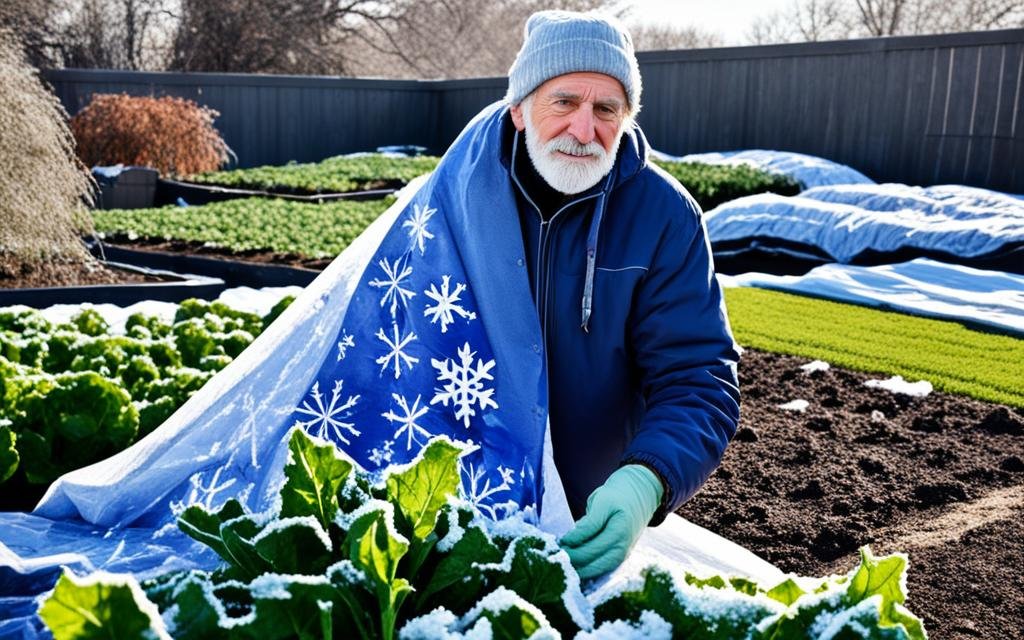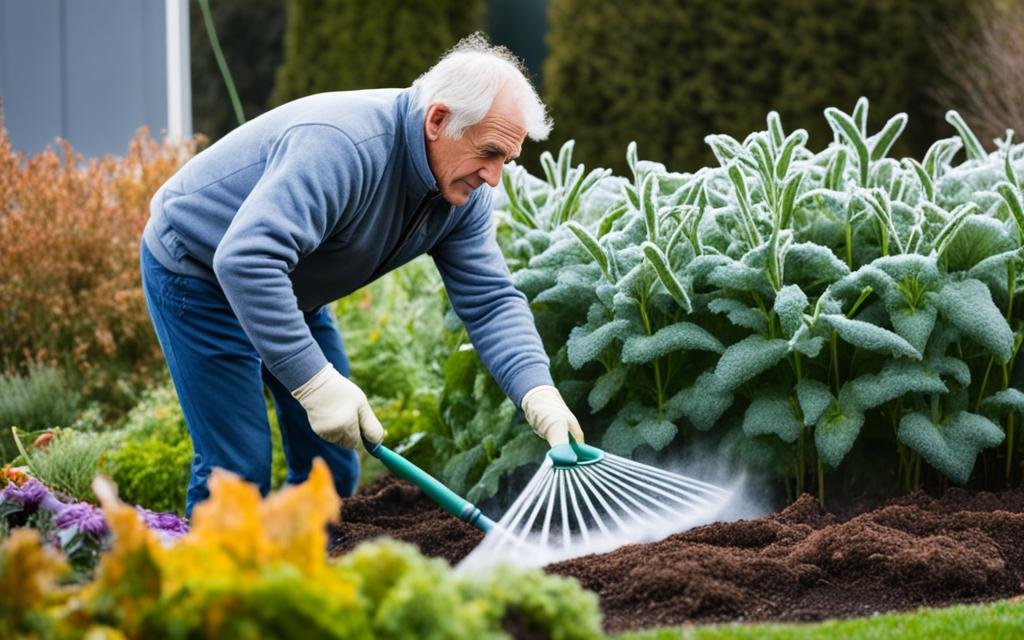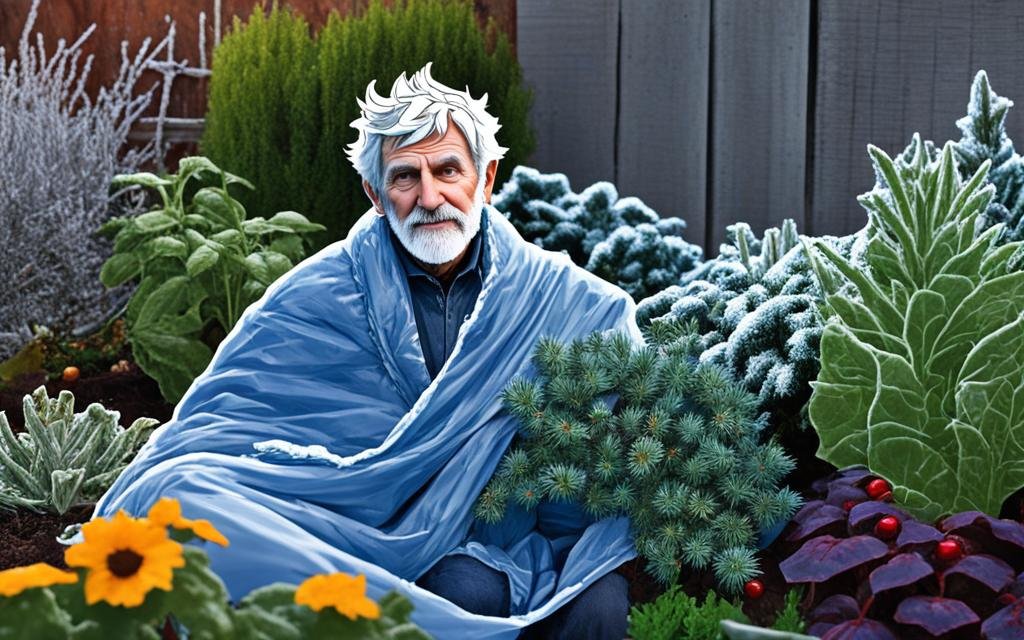Did you know many plants get damaged not in deep winter, but in the tricky frosts of fall and spring? Yes, new seedlings, tender perennials, and exotic plants like palms and banana trees often face frost damage. They suffer from blackened leaves and don’t grow well1. As gardeners, we must learn how to protect our gardens from frost to keep our plants healthy during cold months. A good method is to cover perennial plants with a thick layer of straw or dried leaves. This helps keep them warm when temperatures drop2. Also, watering your plants less during winter matches their lower water needs, which stops ice from forming on chilly days3.
Protecting plants from frost isn’t just about keeping them warm; it’s about making your garden strong. Some bulbs can survive a hard freeze, while others should be kept inside away from the cold. What you plant and how you care for it is key to your garden’s success2. In my own garden (northeast, Texas), I bring potted plants indoors, mulch properly but keep the mulch from touching the trunks to avoid disease, and choose plants that can handle the frost in my area13. Let’s take on the challenge of keeping our beloved plants safe, year after year.
Understanding the Threat of Frost to Your Garden
As a dedicated gardener, I’ve learned to balance growing plants and guarding them against cold snaps. Frost isn’t just a minor problem—it deeply affects garden vitality and plants’ lives. When the mercury dips to freezing or below, frost poses a serious risk, potentially killing sensitive plants.
The Science of Frost and Plant Damage
Let’s explore how frost impacts plant life. When it gets really cold, ice can form inside plant cells. This leads to cell damage and dehydration. Different plants have different frost tolerance levels. For example, broccoli and kale can handle down to about 27-29°F4, while cucumbers and tomatoes get hurt at slightly below 32°F4.
This damage causes plants to look blackened and limp, a sight no gardener wants. It shows the importance of keeping plants safe from the cold.

Identifying Plants Most at Risk
Knowing which plants frost hits hardest is key to prevention. Young sprouts and tender perennials are especially at risk. Tropical plants, like bananas and palms, also suffer from unexpected cold, showing browning leaves or deformed growth. Learning about frost resistance helps make wise planting choices. Hardy veggies like cabbage can take temperatures below 28°F4.
In short, getting to grips with frost and its dangers is vital. This insight guides gardeners in keeping their gardens thriving through the winter.
Pre-Winter Gardening: Prep Steps for Plant Safety
As winter’s chill draws near, gardeners need to protect their plants. Knowing how to keep plants safe from frost is vital. Let’s look at changing your garden care and watering habits to keep plants strong against frost.
Adjusting your Irrigation Routine
Changing how often you water is crucial as it gets colder. Less watering prevents soggy soil, which frost can damage further. Dry soil keeps plants warmer, important for frosty nights5. Watering before a predicted frost can warm the soil slightly, offering some protection5.
The Right Time to Cut Back Perennials
Pruning perennials at the right time also helps in frost protection. Wait until the plants are dormant, shown by brown, dead foliage. This ensures they’re not harmed during pruning. Pruning too early or late might hurt their ability to withstand cold.

Adding a thick mulch layer around your garden beds can also help. About 6 inches of straw, leaves, or store-bought mulch keeps roots warm and moist6. You can also cover sensitive plants with frost cloths or burlap on cold nights for extra frost defense.
Using these methods, you can make your garden ready for winter. With careful preparation, your garden will bloom beautifully in spring. Remember, success comes from timely and thoughtful preparation, keeping your garden lively through cold seasons.
Making the Move: When to Bring Plants Indoors
As a gardener, it’s crucial for me to know when to bring my plants inside. This protects them from frost damage. Summers are great for growing houseplants and succulents outside. But when it gets colder, things get tricky.
Temperatures below 45°F can harm these delicate plants7. Moving them indoors before it gets too cold is essential for their well-being.
I make sure my home feels like summer for them. Many of my plants come from humid places and slow down in winter7. They need more humidity once inside. Dry winter air in heated homes can be tough on them. So, I use a humidifier or place them on wet pebble trays to help out.
Houseplants and Succulents Winter Care
It’s important to adjust indoor temperatures for winter. Plants like it cool and stable, around 60°F to 69°F during the day. At night, they prefer it a bit cooler, about 10 degrees lower7. This keeps them happy and healthy through winter. Trimming them a bit when bringing them inside helps them adapt and grow well indoors7.
| Condition | Requirement |
|---|---|
| Temperature Day | 60°F to 69°F |
| Temperature Night | 50°F to 59°F |
| Humidity | High (use humidifiers or trays with pebbles) |
| Lighting | Mimic natural outdoor light as closely as possible |
| Pruning | Light trimming to encourage new growth |
By making these adjustments, I keep my plants safe from frost. This lets them keep growing throughout winter. Paying attention to what each plant needs helps me keep them vibrant and green, making my home a brighter place.
The Layer of Protection: Benefits of Mulching
As winter approaches, it’s vital for gardeners to protect their plants from the cold. Using the right winter care strategies is key to reducing weather damage. Mulching is a top method for this. It keeps soil moisture steady and helps control soil temperature during cold spells.
Choosing the Right Mulch for Your Garden
It’s important to pick the best mulch for frost protection. Mulches like straw, hay, and wood chips are great because they insulate well. While mulch helps blueberries and blackberries by keeping them moist and warm, some plants don’t do well with too much moisture8. To find the best mulch for your plants and local weather, talk to local Extension Offices9.
Proper Mulch Application Techniques
Applying mulch correctly is crucial for plant protection. You should wait until the ground freezes before adding mulch. This keeps the cold even, helping plants stay dormant in winter10. A 2 to 4-inch thick layer of mulch is most effective. Just make sure it doesn’t touch plant stems or trunks to prevent moisture problems and pests98.
Mulching is a powerful tool for cold weather gardening when done right. The secret is to select the suitable mulch and apply it at the best time. This ensures your garden is protected, setting your plants up for a vibrant spring.
Frost Away From Plants: Protective Tactics
To effectively protect plants from frost, it’s crucial to understand the specific frost and freeze thresholds that dictate proactive measures in gardening. Missoula’s average first frost date falls on September 22nd. This signals the start of colder nights affecting garden plants11. By mid-October, gardeners in this region might expect the first freeze. This prompts a quick response to protect sensitive plants from damage11.
Understanding what your plants can tolerate is key to frost protection. The National Weather Service issues frost advisories when temps are expected to fall between 33-36°F12. This signals it’s time for protective measures. Frost cloths or plant covers can provide a crucial barrier against the cold.
When temps are predicted to drop between 36 degrees to 32 degrees Fahrenheit, a frost advisory is usually in place11. I cover vulnerable garden sections with frost blankets during these times. Tender vegetables and flowering annuals are especially at risk, according to the University Extension guide’s frost tolerance listings11.
When a freeze warning indicates a high chance of temperatures dropping to 32°F or lower, it’s time to take serious action11. This means switching to more insulated solutions like cold frames. These setups are better for managing harsher cold snaps. If temperatures dip below 32°F, especially during a light freeze (29° to 32°F), plants might get damaged unless protected211.
To make my frost protection efforts work, I keep a close eye on weather reports. Using cold frames and cloches keeps my vegetables and perennials growing, even in difficult weather.
| Temperature Range | Expected Condition | Recommended Protection Method |
|---|---|---|
| 33°F – 36°F | Frost Advisory | Use frost cloths or plant covers |
| 29°F – 32°F | Light Freeze | Employ insulated setups like cold frames |
| Below 29°F | Moderate to Severe Freeze | Utilize greenhouse or heated plant shelters |
In conclusion, your actions to protect plants from frost should match the forecasted weather’s severity. With early preparation and the right approach, you can keep your garden thriving, despite the frost.
Garden Innovation: The Role of Cloches in Frost Protection
In my gardening journey, I’ve learned a lot about keeping plants safe from frost. One effective way is using cloches. These are like personal greenhouses for single plants, protecting them in winter.
Cloches are great in vegetable gardens. They protect young plants by trapping heat. Glass cloches are traditional, but plastic ones are now more common. They’re light and less likely to break. Cloches usually look like a dome or bell and cover each plant well13.
Using Cloches for Vegetable Gardens
Placing cloches over vegetables can make the growing season longer. In cold areas, they let you grow a second round of crops in fall. But, you need to watch for weeds under them13.
DIY Cloche Solutions With Household Items
You can make your cloches with things like plastic jugs. This saves money and reduces waste. Just be sure to open them on hot days to stop plants from getting too warm13.
While cloches protect plants from cold, they can affect pollination. It’s important to open them sometimes to keep plants healthy13.
| Feature | Benefit |
|---|---|
| Microclimate Creation | Keeps plants several degrees warmer, reducing frost damage risk14 |
| Extended Growing Season | Allows for a second round of planting, increasing productivity13 |
| DIY Options | Cost-effective and environmentally friendly using recycled materials |
| Ventilation Needed | Prevents overheating and disease, maintaining plant health13 |
Cloches play a key role in frost protection. They fit well into gardening practices that focus on caring for plants in winter.
Creating Microclimates: Strategic Plant Placement
As a gardener, protecting plants from frost is a big concern, especially in early spring or late fall. I’ve found that making microclimates by placing plants carefully really helps. This can keep the frost away and let the growing season last longer.
Utilizing Walls and Fences for Warmth
Putting plants near south- or west-facing walls uses the heat these walls store during the day. At night, the walls give off this warmth. This creates a warmer microclimate around them. This trick can really make a difference in protecting plants from frost. For example, in cities, buildings can keep areas warmer, which helps fight off frost15.
Leveraging Natural Sunlight and Shelter
I aim to place plants where they get plenty of morning sun but are protected from strong winds. Using sun traps or planting near reflective surfaces boosts warmth, helping against frost15. Also, using hedges or rows of trees as windbreaks helps keep the microclimate stable15.
Knowing how to use these methods has really helped protect my plants from frost. It also makes my garden healthier and more productive all year. This gardening strategy helps prevent frost damage and creates a more lively, tough garden.
The Importance of Winter Watering Practices
As winter arrives, it’s vital for gardeners to know how to protect their plants. In places with dry air like Colorado, keeping the roots of plants watered is essential. This helps plants stay strong against the cold
Watering in winter might seem odd, but doing it right is crucial. I find that watering in the late morning allows the soil to soak up water and warmth. This can prevent freezing at night16).
In areas with little rain during winter, plants are at greater risk. When it’s above 40 degrees Fahrenheit, watering helps. It creates a warmer area around the roots, protecting them from the cold16).
Knowing your area can make winter watering more effective. For example, in windy spots, buildings can reflect heat back to your garden, needing more water16). In contrast, places with a lot of snow don’t need as much water. The snow acts like insulation17).
Using soaker hoses or soft spray wands can be gentle on the frozen ground16). Different plants need different amounts of water. For example, new trees need about 10 gallons of water for each inch of trunk per session for their roots to grow strong16).
It’s also key to consider the plant’s type and structure. Young shrubs and perennials are more at risk in the cold. They need a good watering routine set before it gets too cold16).
Shielding Your Potted Plants From the Cold
As winter nears, gardeners start to worry about keeping their plants warm, especially the ones in pots. Potted plants don’t have the earth’s natural warmth and can get cold easily. Good care through the winter means doing things early and quickly to keep them alive when it’s very cold.
Insulating Containers Against Harsh Temperatures
Wrapping pots with bubble wrap or burlap keeps plants warm in freezing weather. Burying pots so only the top shows uses the ground’s warmth to protect the roots from freezing18. Lifting pots off the ground stops water from gathering and freezing underneath, adding extra protection18.
The Merits of Grouping Pots Together
Putting several container plants close in a protected spot can slightly raise the temperature and keep moisture in. This method shields plants from the cold and makes covering them with frost cloths or cloches easier, helping them stay warm18.
These methods highlight the need for planning, not just reacting, to cold weather. By picking the right materials for insulation, placing pots wisely, and knowing when to cluster them, your winter plant care can be a big success. This helps your potted plants survive the winter.
| Method | Description | Effectiveness |
|---|---|---|
| Relocating indoors | Moving plants to garages or sheds to protect from frost. | High19 |
| Watering | Thorough soil watering (excluding succulents) to retain heat at the soil level. | Medium to High18 |
| Grouping pots | Arranging multiple pots closely in a sheltered area to create a warmer microclimate. | Medium18 |
Using these methods in your winter plant care protects your plants and enriches your gardening. It ensures your beloved plants keep thriving, even when it gets colder19.
Selecting Frost-Tolerant Plants for Your Landscape
I’m a gardening enthusiast with a focus on the winter garden. To protect your garden from frost, it’s best to choose plants that can handle the cold. If plants can’t survive the cold, they’re at high risk of damage, especially in places not used to cold weather20. My goal is to make a garden that does well even when it’s cold.
Embracing Native Species for Hardiness
Starting with native plants is my first step to a strong garden. These plants are used to the local weather and need less help to stay safe from frost. I choose plants like the Echinacea DOUBLE CODED™ Collection and Aruncus ‘Chantilly Lace’ because they’re good for bees and keep deer away21. This way, my garden is better prepared for frost and helps the local animals and plants.
Exploring Plant Varieties by Hardiness Zones
Using the US Hardiness Zone map helps me pick the right plants for my garden. I select plants that are suitable for my zone to help them survive frost. For instance, covering tender annuals at 32°F (0°C) can stop frost damage22. My garden has many plants like the Achillea Firefly Collection and Brunnera macrophylla ‘Jack of Diamonds’. They are chosen for their ability to handle the cold and add beauty year-round2122.

My name is Michelle Warren, and I’m the founder of Peaceful Gardening. As a 10-year breast cancer survivor, I’ve discovered the profound therapeutic power of gardening. This journey has not only helped me recover but has also become my passion and a source of ongoing peace and joy.
Peaceful Gardening was born from my desire to share the healing benefits of gardening with others. Whether you’re facing health challenges, dealing with stress, or simply looking to connect more deeply with nature, this space is for you.
Over the past decade, I’ve cultivated not just plants, but a deep understanding of how gardening can positively impact mental health. I’ve worked with local community gardens, led workshops on mindful gardening practices, and collaborated with mental health professionals to develop gardening-based stress reduction programs.
Peaceful Gardening was born from my desire to share the healing benefits of gardening with others. Whether you’re facing health challenges, dealing with stress, or simply looking to connect more deeply with nature, this space is for you.
Here, you’ll find evidence-based advice on using gardening as a tool for mindfulness, stress relief, and emotional healing. I share personal stories, practical tips, and scientifically-backed information on how to create your own therapeutic garden space, no matter the size of your yard or balcony.
My mission is to help you discover the joy, peace, and healing that comes from nurturing plants and connecting with nature. Join me in exploring how the simple act of tending to a garden can transform your mental and emotional wellbeing.
Welcome to Peaceful Gardening – let’s grow together towards better mental health!”

